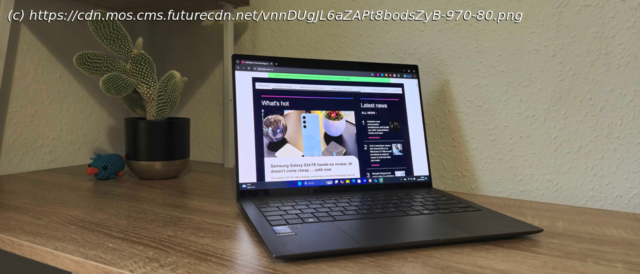Lunar Lake laptops are here
Asus Zenbook S 14: Two-minute review
The Asus Zenbook S 14 has given us our first real look at what an Intel Lunar Lake laptop is capable of, and we’re definitely impressed by what we’ve seen.
Its ceralumium design is stunning, with the material boasting a rugged nature in a lightweight and slim package (coming in at 1.2kg / 2.7lbs and a thickness of 1.2cm / 0.5 inches). Best of all, it doesn’t get easily ruined by fingerprint smudges – something which can’t be said for many other laptops we’ve tested.
The 14-inch 3K 120Hz OLED display is also beautiful, offering a fluid experience as you scroll through page after page, and a great screen for watching a film after a busy day of work. Unfortunately, the 14-inch screen size can feel a little cramped the moment you want to run two windows side-by-side.
I also wish it had a few more ports. The five the Zenbook S 14 offers isn’t always enough, and I would have been happy to sacrifice some sleekness to sneak in an extra USB port and maybe an SSD card slot.
Performance-wise there’s less to complain about. In our benchmarks and real world tests, the Asus Zenbook S 14 performed very well, and we have no doubt it’ll serve you well as a productivity machine – even when you’re trying to complete several tasks on the PC at once.
Though if you’ve been drawn in by Intel’s boasts about Lunar Lake’s gaming performance, don’t get it twisted. While this machine can run titles like Cyberpunk 2077, you’re not getting any higher than the lowest graphical settings, so if gaming prowess is something you value I’d highly recommend looking elsewhere (especially at this price – more on that in a moment).
The AI side of things are a little trickier to test right now, because while this machine is Copilot+ ready thanks to Lunar lake’s superb NPU, Copilot+ itself isn’t ready – the new features don’t arrive until November. Though when they do arrive, this laptop should have the specs to handle everything Microsoft wants to throw at it.
However this power and beauty comes at a price – $1,499.99 / £1,599 / AU$3,399 for the standard Intel Core Ultra 7 Processor 258V, 32GB of RAM, and 1TB SSD storage model to be precise. And in the UK things can get even pricier; this review has us testing out the £1,749 model, which boasts a 1TB SSD, 32GB of RAM, and an Intel Core Ultra 9 288V Processor.Asus Zenbook S 14: Price and availability
How much does it cost? Starts at $1,499.99 / £1,299 / AU$3,399
When is it available? Available now
Where can you get it? Available in the US, UK, and Australia
The Asus Zenbook S 14 has a few model variants depending on where you live. The standard model available in the US, UK, and Australia costs $1,499.99 / £1,599 / AU$3,399 and nets you an Intel Core Ultra 7 Processor 258V, 32GB of RAM, and a 1TB SSD.
In the UK you can also find a more affordable £1,299 model which sports an Intel Core Ultra 5 226V Processor , 16GB of RAM, and a 512GB SSD. There’s a top of the line model as well with a 1TB SSD, 32GB of RAM, and an Intel Core Ultra 9 288V Processor which costs £1,749. At the time of writing, there’s no word yet when these models (especially the souped up Ultra 9 model) will make it to other regions.
This review was conducted using the top of the line specs, so I can get a feel for what Asus’ best Zenbook S 14 model is capable of.Asus Zenbook S 14: SpecsAsus Zenbook S 14: Design
Ceralumium finish looks beautiful
Lightweight and durable
Too few ports
This slim and lightweight laptop (weighing in at 1.2kg / 2.7lbs and measuring just 1.2 cm / 0.5 inches thick) is ideal for sticking in your rucksack and carrying with you all day with little challenge.
But being lightweight doesn’t mean it isn’t durable. The Zenbook S 14 is clad in Asus’ new ceralumium material which it says combines the best properties of ceramic and aluminum to create a portable yet resilient laptop, which also looks gorgeous. Our Computing Editor Christian Guyton likened the laptop’s look and feel to an ancient Roman tablet in these regards and I can absolutely see where he’s coming from.
Home
United States
USA — software Asus Zenbook S 14 review: the Lunar Lake laptop delivers power and...






